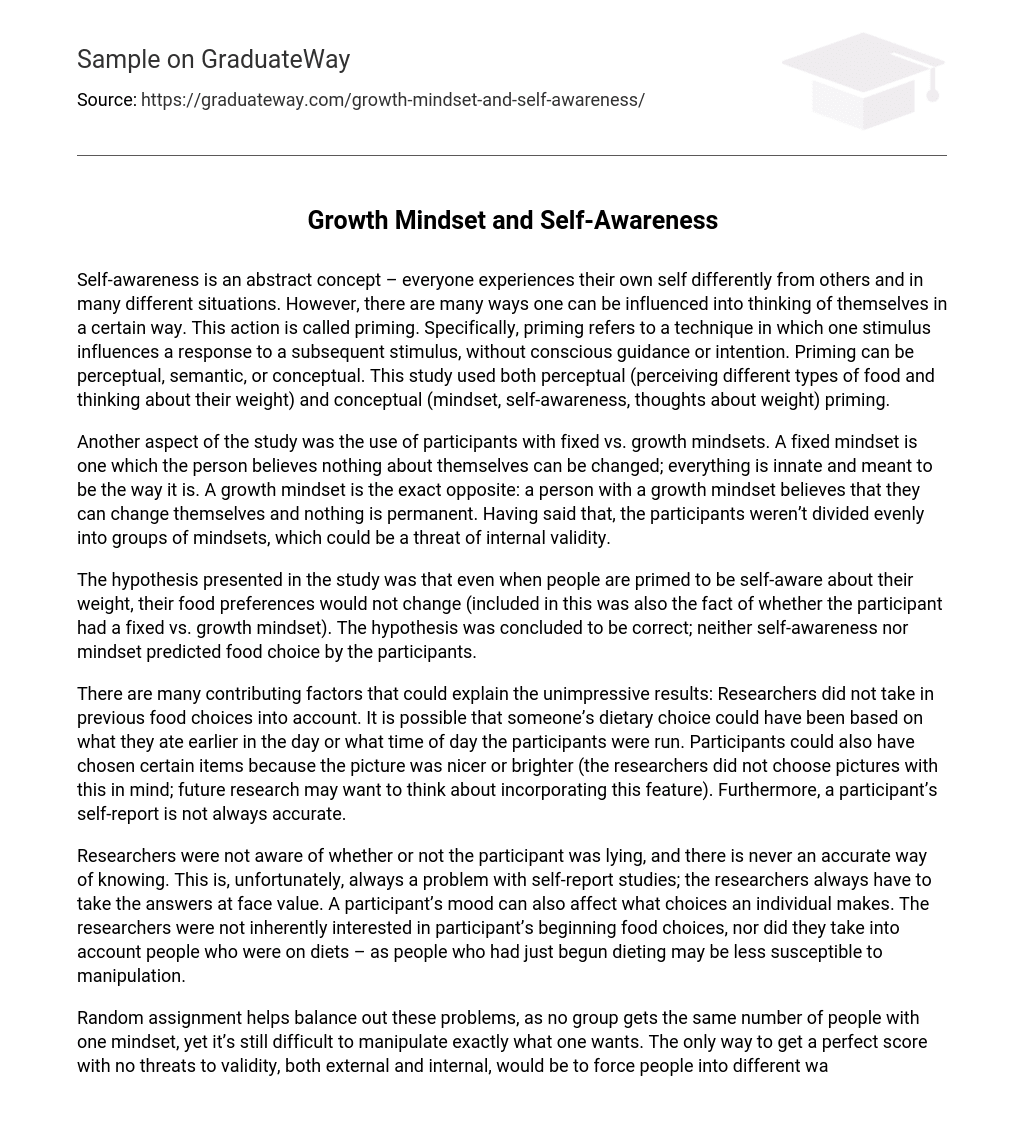Self-awareness is an abstract concept – everyone experiences their own self differently from others and in many different situations. However, there are many ways one can be influenced into thinking of themselves in a certain way. This action is called priming. Specifically, priming refers to a technique in which one stimulus influences a response to a subsequent stimulus, without conscious guidance or intention. Priming can be perceptual, semantic, or conceptual. This study used both perceptual (perceiving different types of food and thinking about their weight) and conceptual (mindset, self-awareness, thoughts about weight) priming.
Another aspect of the study was the use of participants with fixed vs. growth mindsets. A fixed mindset is one which the person believes nothing about themselves can be changed; everything is innate and meant to be the way it is. A growth mindset is the exact opposite: a person with a growth mindset believes that they can change themselves and nothing is permanent. Having said that, the participants weren’t divided evenly into groups of mindsets, which could be a threat of internal validity.
The hypothesis presented in the study was that even when people are primed to be self-aware about their weight, their food preferences would not change (included in this was also the fact of whether the participant had a fixed vs. growth mindset). The hypothesis was concluded to be correct; neither self-awareness nor mindset predicted food choice by the participants.
There are many contributing factors that could explain the unimpressive results: Researchers did not take in previous food choices into account. It is possible that someone’s dietary choice could have been based on what they ate earlier in the day or what time of day the participants were run. Participants could also have chosen certain items because the picture was nicer or brighter (the researchers did not choose pictures with this in mind; future research may want to think about incorporating this feature). Furthermore, a participant’s self-report is not always accurate.
Researchers were not aware of whether or not the participant was lying, and there is never an accurate way of knowing. This is, unfortunately, always a problem with self-report studies; the researchers always have to take the answers at face value. A participant’s mood can also affect what choices an individual makes. The researchers were not inherently interested in participant’s beginning food choices, nor did they take into account people who were on diets – as people who had just begun dieting may be less susceptible to manipulation.
Random assignment helps balance out these problems, as no group gets the same number of people with one mindset, yet it’s still difficult to manipulate exactly what one wants. The only way to get a perfect score with no threats to validity, both external and internal, would be to force people into different ways of life, and that’s obviously unethical. Nonetheless, the scores presented here are as accurate as can be and should not be disregarded.
A way to correct for some of the problems found would be to send the survey out to more people, over a period of weeks or months; it could also be sent to the exact same group of people a few months later to see how their choices change (if they do at all). This would address the idea that mindset is an important part of one’s choices. This problem – the unpredictability one finds with doing self-report studies – is known as a threat of validity, specifically internal.
The authors acknowledge that there are several threats to both internal and external validity in this study. First, the time frame in which the survey was available was much too small (an example of internal validity). The survey was only available for about a week to a limited number of participants. Secondly, due to the small sample size (n = 37) pooled from two sections of experimental psychology at the University of Central Oklahoma, this data cannot be generalizable to the entire population, which is an example of external validity.
Future research should incorporate more participants and may consider using a better scale of food selection to attempt to combat any of these problems with validity that were discussed.
In conclusion, future research is required to investigate this interaction sufficiently. The present research had several flaws in the methodology of the study, specifically with the small time frame and sample size. Future research should attempt to fix this in order to get a more accurate result that could be generalized to the population. Having this study be replicated several times could be interesting in seeing how different mindsets and self-awareness interact with other choices, not simply food preferences.





